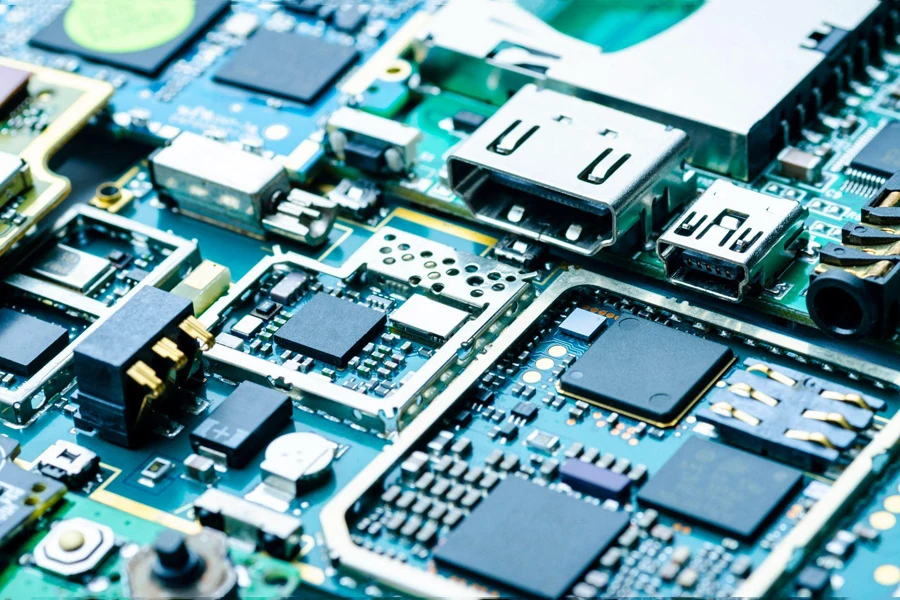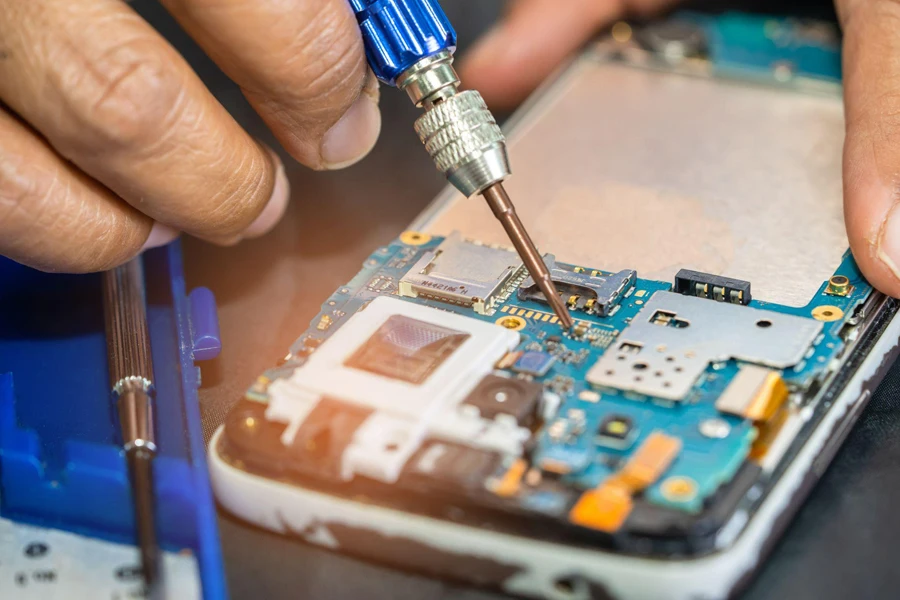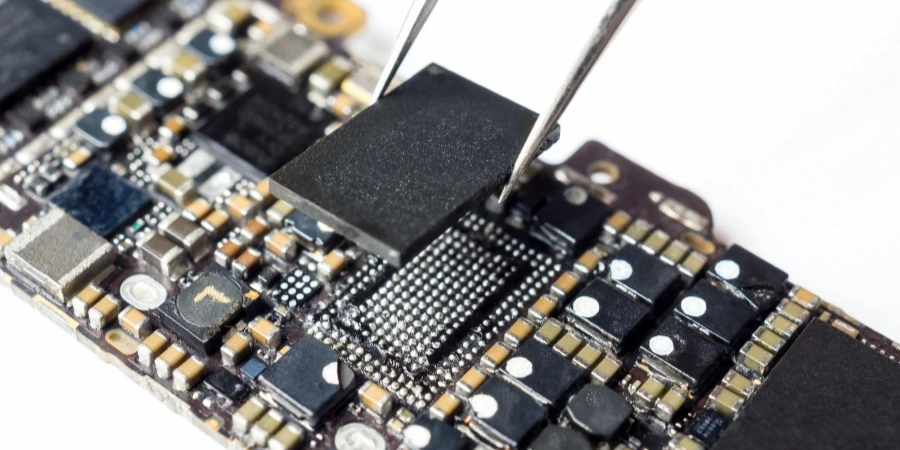Selecting the right motherboard is crucial for ensuring optimal PC performance and reliability in 2024. A motherboard serves as the backbone of a computer, connecting all the vital components such as the CPU, RAM, and storage devices. The right choice can significantly enhance system efficiency, stability, and future upgrade potential. With advancements in technology, modern motherboards now offer a wide range of features, including support for the latest CPUs, high-speed connectivity options, and enhanced audio and networking capabilities. By understanding these features and how they align with specific needs, decision-makers can ensure that their systems run smoothly and efficiently, meeting the demands of today’s computing environments.
Table of Contents
Understanding Motherboard Types and Their Uses
Current Market Trends and Insights
Key Considerations for Selecting a Motherboard
Top Motherboard Models for 2024
Conclusion
Understanding motherboard types and their uses

Motherboards are the central hub of any PC, responsible for connecting and coordinating the various components such as the CPU, RAM, and storage devices. In 2024, selecting the right motherboard is vital for ensuring optimal performance, reliability, and future-proofing your systems. This section explores the three main types of motherboards—ATX, MicroATX, and Mini-ITX—and their specific uses.
ATX motherboards
ATX motherboards are the most common and versatile type, offering a balance of features, expandability, and performance. These motherboards are designed for high-performance and gaming setups, making them ideal for demanding applications.
ATX motherboards typically measure 305 x 244 mm, providing ample space for multiple expansion slots, including PCIe slots for graphics cards, sound cards, and other peripherals. They often come equipped with up to seven expansion slots, allowing for extensive customization and upgrades. This makes them suitable for high-end gaming rigs, content creation workstations, and any setup requiring significant processing power and peripheral support.
One of the standout features of ATX motherboards is their robust power delivery systems. For instance, models like the Gigabyte Z790 Aorus Elite AX offer exceptional power management, supporting the latest Intel and AMD processors with enhanced VRMs (voltage regulator modules) to ensure stable and efficient power supply, crucial for overclocking and high-load tasks.
Additionally, ATX motherboards often include a wide array of connectivity options. This includes multiple USB ports, SATA connectors, M.2 slots for NVMe SSDs, and advanced networking features such as Wi-Fi 6 or even Wi-Fi 7. These features cater to users who need comprehensive connectivity and high-speed data transfer capabilities.
MicroATX motherboards
MicroATX motherboards are a smaller variant of the ATX standard, measuring 244 x 244 mm. They are designed to offer a balance between performance and space efficiency, making them ideal for both mid-range gaming PCs and office workstations where space is a consideration.
Despite their smaller size, MicroATX motherboards still provide a good level of expandability with up to four expansion slots. This allows for a decent amount of customization while maintaining a compact form factor. These motherboards are perfect for systems that require fewer expansion cards but still need the power and features offered by larger boards.
The MSI MAG B660 Tomahawk Wi-Fi is a prime example of a high-performing MicroATX motherboard. It supports the latest Intel Alder Lake CPUs and comes with features such as three M.2 slots, integrated Wi-Fi 6, and a robust VRM setup. This ensures that it can handle demanding tasks without compromising on performance, all within a more compact and affordable package.
MicroATX motherboards are also known for their cost-effectiveness. They generally offer many of the features found in ATX motherboards but at a lower price point. This makes them a popular choice for budget-conscious builds where performance and expandability are still important considerations.
Mini-ITX motherboards
Mini-ITX motherboards are the smallest of the three, measuring just 170 x 170 mm. These compact boards are designed for small form factor (SFF) PCs, making them ideal for builds where space is at a premium, such as home theater PCs (HTPCs) and portable gaming systems.
Despite their small size, Mini-ITX motherboards can be surprisingly powerful. They typically feature two RAM slots, one PCIe slot, and support for modern CPUs. The MSI MEG Z690I Unify is a standout Mini-ITX motherboard that supports Intel’s 12th-gen Alder Lake processors. It includes features like Thunderbolt 4, multiple M.2 slots, and Wi-Fi 6E, making it a powerful option for compact builds.
Mini-ITX motherboards are designed to offer a high level of performance in a very small footprint. They are perfect for users who need a powerful PC that can fit into tight spaces without sacrificing too much in terms of performance and connectivity. These motherboards often come with built-in Wi-Fi and Bluetooth, reducing the need for additional expansion cards and helping to keep the build compact and tidy.
In summary, understanding the different types of motherboards and their uses is crucial for making an informed decision in 2024. Whether the requirement is for a high-performance gaming rig, a balanced and space-efficient workstation, or a compact and powerful small form factor PC, there is a motherboard type designed to meet these needs. By choosing the right motherboard, it is possible to ensure that systems are not only optimized for current tasks but also capable of handling future upgrades and advancements in technology.
Current market trends and insights

The motherboard market is continually evolving, driven by advancements in technology and increasing demands for higher performance and connectivity. In 2024, several trends are shaping the industry, including the adoption of PCIe 5.0, integration of advanced wireless connectivity like Wi-Fi 6E and Wi-Fi 7, and enhanced audio and networking capabilities. These trends are critical for improving overall system performance and meeting the needs of modern computing environments.
Experts currently value the motherboard market at US$ 12.5 billion in 2023, and they expect it to reach US$ 16.3 billion by 2028. They estimate this boost will happen at a 5.5% compound annual growth rate (CAGR) from 2023 to 2028.
Increasing demand for PCIe 5.0
One of the most significant trends in the motherboard market is the growing adoption of PCIe 5.0 slots. PCIe 5.0 offers twice the data transfer rate of PCIe 4.0, reaching up to 32 GT/s (gigatransfers per second). This increase in bandwidth is crucial for high-performance applications, including gaming, content creation, and data-intensive tasks.
The impact of PCIe 5.0 on performance is substantial. It enables faster communication between the motherboard and connected components, such as graphics cards, SSDs, and network cards. For instance, the Asus ROG Strix Z790-A Gaming Wi-Fi II features PCIe 5.0 slots, providing support for the latest high-speed components and ensuring future-proofing for upcoming hardware innovations.
Motherboards like the Gigabyte Z690 Aorus Master also incorporate PCIe 5.0, making them ideal for users seeking the highest levels of performance and expandability. These boards typically include multiple M.2 slots supporting PCIe 5.0, allowing for rapid data transfer and reduced latency, which is particularly beneficial for gamers and professionals working with large datasets.
Integration of Wi-Fi 6E and Wi-Fi 7
Another key trend is the integration of advanced wireless connectivity technologies, such as Wi-Fi 6E and the emerging Wi-Fi 7 standard. Wi-Fi 6E extends Wi-Fi 6 into the 6 GHz band, providing more bandwidth and less interference, which results in faster and more reliable wireless connections.
The benefits of Wi-Fi 6E and Wi-Fi 7 in modern motherboards are significant. They offer increased throughput, lower latency, and improved performance in densely populated environments. For example, the MSI MEG Z690I Unify is equipped with Wi-Fi 6E, ensuring high-speed wireless connectivity and enhancing the overall user experience in both gaming and professional applications.
Wi-Fi 7, although still in development, promises even greater improvements. It aims to provide up to 46 Gbps of throughput, substantially reducing latency and increasing the efficiency of data transfer. Motherboards integrating Wi-Fi 7 will be capable of supporting a larger number of connected devices simultaneously, making them ideal for smart homes and IoT applications.
Enhanced audio and networking capabilities
High-quality audio and networking components are increasingly important in modern motherboards, as they significantly enhance the overall computing experience. Superior audio components ensure clear and immersive sound, which is essential for gaming, multimedia consumption, and professional audio work.
Motherboards like the Asus ROG Strix B550-F Gaming Wi-Fi feature advanced audio chipsets that provide high-definition sound and noise-canceling capabilities. This ensures a rich audio experience, whether for gaming, watching movies, or conducting video conferences.
Networking capabilities are equally critical. Modern motherboards often come with integrated high-speed Ethernet ports and advanced networking technologies. For instance, the MSI MAG B660 Tomahawk Wi-Fi includes a 2.5 GbE LAN port and Wi-Fi 6, offering robust and fast network connectivity. This is vital for online gaming, streaming, and remote work, where stable and high-speed internet connections are a necessity.
In summary, the motherboard market in 2024 is characterized by significant advancements in PCIe technology, wireless connectivity, and audio and networking components. These trends ensure that motherboards can meet the increasing demands for performance, connectivity, and overall user experience in modern computing environments. By understanding and leveraging these trends, decision-makers can select motherboards that will not only meet current needs but also accommodate future technological advancements.
Key considerations for selecting a motherboard

Selecting the right motherboard is critical for optimizing system performance, reliability, and future upgradeability. Here are key factors to consider when choosing a motherboard in 2024.
CPU compatibility
The first and foremost consideration when selecting a motherboard is CPU compatibility. The motherboard must have a socket that matches the chosen CPU. For instance, Intel’s latest CPUs use the LGA 1700 socket, while AMD’s Ryzen processors typically use the AM5 socket. Ensuring this compatibility is vital for the system to function correctly and take full advantage of the CPU’s capabilities.
Intel’s 13th and 14th Gen CPUs are supported by motherboards like the Asus ROG Strix Z790-A Gaming Wi-Fi II, which offers robust power delivery and multiple PCIe 5.0 slots for advanced performance. On the AMD side, the ASRock X670E Taichi is designed to support the Ryzen 7000 series processors, providing exceptional stability and extensive connectivity options.
Expansion slots and connectivity
Expansion slots are crucial for adding components such as graphics cards, sound cards, and network cards. The number and type of expansion slots can significantly impact a system’s functionality. Common expansion slots include PCIe slots of varying sizes (x16, x8, x4, x1).
For example, the Gigabyte B650E Aorus Master features four PCIe 5.0 M.2 slots, allowing for rapid data transfer and reduced latency, which is particularly beneficial for gamers and professionals working with large datasets. Additionally, this motherboard includes 13 USB ports, enhancing connectivity options for peripherals and external storage devices. These slots ensure that users can connect multiple devices without any compromise on performance or speed.
Memory support and overclocking
The number of RAM slots and the maximum memory support are vital for determining a system’s potential for multitasking and memory-intensive applications. Most modern motherboards support DDR5 memory, which offers higher speeds and better efficiency than DDR4.
Motherboards like the MSI MAG B760 Tomahawk Wi-Fi are equipped with robust VRMs (Voltage Regulator Modules) that ensure stable power delivery, crucial for overclocking the CPU and RAM. This model supports up to 128GB of DDR5 RAM and features three M.2 slots for additional storage options. Overclocking capabilities depend heavily on the quality of the VRMs, which manage the power supplied to the CPU and memory, ensuring they operate efficiently even under heavy loads.
Form factor and build compatibility
Motherboards come in various form factors, including ATX, MicroATX, and Mini-ITX, each catering to different build sizes and requirements. ATX motherboards, like the Gigabyte Z790 Aorus Elite AX, are full-sized boards suitable for standard desktop cases, offering extensive expandability and features.
MicroATX boards, such as the Asus ROG Strix B550-F Gaming Wi-Fi, are more compact and fit in smaller cases, providing a balance between expandability and size. These motherboards typically measure 244 x 244 mm and offer enough slots for a moderate number of peripherals, making them ideal for mid-range builds. Mini-ITX motherboards, like the MSI MEG Z690I Unify, are designed for small form factor builds, ideal for compact PCs and home theater setups. Measuring just 170 x 170 mm, these boards offer limited expansion slots but still provide high performance and essential features, making them suitable for builds where space is a premium.
Selecting the right form factor ensures compatibility with the PC case and the overall design and layout of the system. It’s essential to match the motherboard size with the intended case to ensure a seamless and efficient build process. For instance, the Mini-ITX form factor is perfect for portable gaming systems or small office setups, while ATX motherboards are suited for high-end gaming rigs and professional workstations requiring extensive expansion capabilities.
By carefully considering CPU compatibility, expansion slots, memory support, and form factor, decision-makers can select motherboards that meet specific needs and enhance overall system performance and reliability. This approach ensures that systems are not only optimized for current tasks but also capable of accommodating future technological advancements.
Top motherboard models for 2024

With the rapid advancements in technology, 2024 brings several top-tier motherboards designed to meet various needs, from high-end gaming to budget-friendly builds. Here’s a look at some of the best models available this year.
High-end Intel: Asus ROG Strix Z790-A Gaming Wi-Fi II
The Asus ROG Strix Z790-A Gaming Wi-Fi II is a top choice for those seeking high performance. This motherboard is designed to support Intel’s 13th and 14th Gen processors, providing robust power delivery and extensive connectivity options.
Key features include Wi-Fi 7 support, which offers ultra-fast wireless connectivity, and multiple M.2 slots for high-speed SSDs. Specifically, it comes with five M.2 slots, four of which support PCIe 4.0, and one supports PCIe 5.0, ensuring future-proofing for upcoming storage technologies. Additionally, the motherboard boasts premium audio with its SupremeFX codec, enhancing the overall multimedia experience. This motherboard also supports DDR5 memory with speeds up to 8000 MHz, ensuring that users can take full advantage of the latest RAM technology. Ideal for gamers and content creators, this motherboard balances power and versatility, making it suitable for high-demand applications.
Premium AMD: ASRock X670E Taichi
The ASRock X670E Taichi stands out as a premium option for AMD users, particularly those utilizing the Ryzen 7000 series processors. This motherboard is built to deliver exceptional performance with its robust design and extensive feature set.
Equipped with dual PCIe 5.0 slots, the ASRock X670E Taichi supports the latest high-speed GPUs and storage devices. It also features a comprehensive connectivity suite, including eight SATA ports and four M.2 slots, providing ample storage options. The board’s VRM design ensures stable power delivery, making it suitable for overclocking. Additionally, the Taichi includes Wi-Fi 6E and Bluetooth 5.2 for advanced wireless connectivity. This model also offers active cooling on both the VRM and primary M.2 drive, ensuring that components remain cool even under heavy loads. The combination of high-end components and cutting-edge technology makes this motherboard a top choice for enthusiasts and professionals alike.
Midrange Intel: Asus ROG Strix B760-F Gaming Wi-Fi
For a midrange option, the Asus ROG Strix B760-F Gaming Wi-Fi offers an excellent balance of performance and features. This motherboard supports Intel’s 12th and 13th Gen Alder Lake processors and provides a robust set of features for gamers and power users.
The ROG Strix B760-F comes with three M.2 slots for high-speed storage, integrated Wi-Fi 6E for fast wireless connectivity, and premium audio powered by the Realtek ALC4080 codec. It also features convenient attach/release latches on PCIe and M.2 slots, making hardware installation easier. The motherboard’s striking appearance, complete with RGB lighting, makes it a standout choice for transparent PC cases. This model supports up to 128GB of DDR5 RAM, ensuring that users have plenty of memory for multitasking and demanding applications.
Budget-friendly option: MSI MAG B760 Tomahawk Wi-Fi
For those on a budget, the MSI MAG B760 Tomahawk Wi-Fi offers excellent value without compromising on essential features. This motherboard supports Intel’s 12th and 13th Gen Alder Lake processors and provides a balanced mix of performance and affordability.
Despite its lower price point, the MSI MAG B760 Tomahawk Wi-Fi includes three M.2 slots, allowing for high-speed storage options. It also features integrated Wi-Fi 6E, providing reliable and fast wireless connectivity. The board’s power delivery system is robust enough to handle moderate overclocking, making it a versatile option for gamers and general users. Its comprehensive I/O panel includes multiple USB ports, a 2.5G LAN port, and advanced audio outputs, ensuring a complete package for budget-conscious builders. This model supports up to 192GB of DDR5 RAM, offering ample memory capacity for various applications.
Balanced choice: Gigabyte Z790 Aorus Elite AX
The Gigabyte Z790 Aorus Elite AX is a balanced choice that combines aesthetics, performance, and connectivity. This motherboard is designed to support Intel’s latest CPUs and comes packed with features that cater to a wide range of applications.
One of the key highlights of the Aorus Elite AX is its aesthetic appeal, featuring RGB lighting and a sleek design. It offers multiple USB ports, including USB 3.2 Gen 2×2, ensuring fast data transfer rates. The motherboard also supports Wi-Fi 6E, providing enhanced wireless connectivity. With four M.2 slots and ample SATA ports, it offers versatile storage options. The robust VRM design supports stable power delivery, making it suitable for both gaming and professional use. This motherboard is ideal for those who need a reliable and feature-rich platform without the premium price tag.
In summary, 2024 brings a range of top-tier motherboards that cater to different needs and budgets. Whether building a high-performance gaming rig or a budget-friendly PC, these models offer the latest features and reliable performance, ensuring that users can build systems that meet their specific requirements and stay future-proofed for years to come.
Conclusion
Choosing the right motherboard is essential for maximizing system performance, stability, and future scalability. By considering factors such as CPU compatibility, expansion slots, memory support, and form factor, decision-makers can ensure their builds meet specific requirements and leverage the latest technologies. Understanding market trends, such as the adoption of PCIe 5.0 and advanced wireless connectivity, can further enhance decision-making. With options ranging from high-end models like the Asus ROG Strix Z790-A Gaming Wi-Fi II to budget-friendly choices like the MSI MAG B760 Tomahawk Wi-Fi, there is a suitable motherboard for every need, ensuring robust and future-proof systems.




